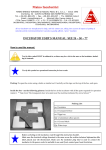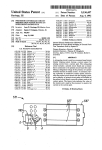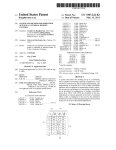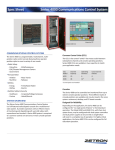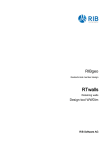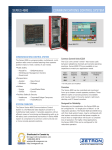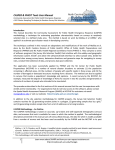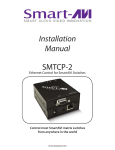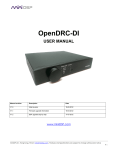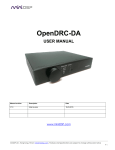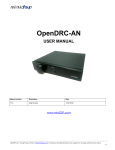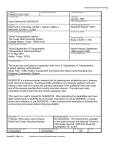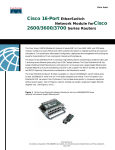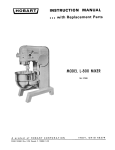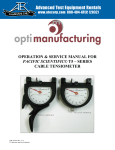Download System and method for optimizing memory usage in a universal
Transcript
US 20140317363A1
(19) United States
(12) Patent Application Publication (10) Pub. No.: US 2014/0317363 A1
Hatambeiki et al.
(54)
(43) Pub. Date:
SYSTEM AND METHOD FOR OPTIMIZING
MEMORY USAGE IN A UNIVERSAL
Oct. 23, 2014
Publication Classi?cation
CONTROLLING DEVICE
(51)
(71) Applicant: UNIVERSAL ELECTRONICS INC.,
Int- Cl
G06F 12/02
(2006.01)
(52) US, Cl,
Santa Ana, CA (US)
CPC .................................. .. 6an 12/023 (2013.01)
USPC
(72) Inventors: Arsham Hatambeiki, Irvine, CA (U S);
Jan VanEe, Irvine, CA (US);
Christopher Lee Somerville, Los
Angeles, CA (US); Daniel Morrionne,
........................................................ ..
(57)
orange’ CA (Us)
711/159
ABSTRACT
A method for optimizing memory usage in a device having a
(73) Assignee; UNIVERSAL ELECTRONICS INC"
universal controlling application includes receiving into the
Santa Ana, CA (Us)
device data for use in con?guring the universal controlling
application Wherein the data is used to identify from Within a
library of command code sets stored in a memory of the
(21)
Appl. No.: 14/209,008
(22)
Flled:
(60)
Related U's' Apphcatlon Data
Provisional application No. 61/788,561, ?led on Mar.
_
device a command code set that is appropriate for use in
Mar“ 13’ 2014
commanding functional operations of the appliance and caus
.
.
ing a non-identi?ed one or more of the command code sets of
the library of command code sets stored in the memory of the
device to be discarded to thereby create freed space in the
memory of the device.
15, 2013.
if
WSTRUK‘IYEEQN S
ALL
E.»
ANBKQR
EEA’FA
SETS
;
Eevice
3 Con?gu ration
1
.2 . 131:; m
iiws-raucrtows
f...» 30%
Patent Application Publication
Oct. 23, 2014 Sheet 1 0f 5
v...
RQUR if;
US 2014/0317363 A1
Patent Application Publication
Oct. 23, 2014 Sheet 2 0f 5
as
RGURE 2
US 2014/0317363 A1
Patent Application Publication
Oct. 23, 2014 Sheet 3 0f 5
3%?
US 2014/0317363 A1
g
“53,4
(I;
is
mairéx
Key
%
E
i
Ham ,‘3-{38
m?mury
m
CW5“; E
w
M“
Geek 2:96
s
mm
?ameréaggic:
é
mama,
/1'
%
1
\ 1m
FEGQRE 3
MS
Patent Application Publication
Oct. 23, 2014 Sheet 4 0f 5
US 2014/0317363 A1
I
§
E‘EViCE
i Eora?guratian
i
492* x
f
\
if” mi
s”
{Ns'iwmwwgé
ANWQR
Ems-R.
HGUREi
§
My {mi
Patent Application Publication
Oct. 23, 2014 Sheet 5 0f 5
US 2014/0317363 A1
EACKUP
FMAGE (3F
HGEJRE S
ERASE
SECQN DA R?
M EMGRY
SQWNEGAE)
QEYHEVEI
NEW
iNSTALL
ANY}
HRMWM‘ZE
STQRE .
.2
EECISN
BQCKU?
ERR?
MEMQR?
FRQM ST
’\
MEMQRY
Y
§:
:
Oct. 23, 2014
US 2014/0317363 A1
[0006] A better appreciation of the objects, advantages,
features, properties, and relationships of the systems and
SYSTEM AND METHOD FOR OPTIMIZING
MEMORY USAGE IN A UNIVERSAL
CONTROLLING DEVICE
methods described hereinafter will be obtained from the
RELATED APPLICATION INFORMATION
forth illustrative embodiments which are indicative of the
detailed description and accompanying drawings which set
[0001] This application claims the bene?t of US. Provi
sional Application No. 61/788,561, ?led on Mar. 15, 2013,
the disclosure of which is incorporated herein in its entirety.
BACKGROUND
various ways in which the principles of the systems and
methods may be employed.
BRIEF DESCRIPTION OF THE DRAWINGS
[0007]
For use in better understanding the exemplary sys
tems and methods described herein, reference may be had to
[0002] This invention relates generally to remote control
systems and, more particularly, to systems and methods for
optimizing memory usage in a universal controlling device.
[0003] Manufacturers typically provide a remote control
with an appliance and, as such, different appliance types of
different manufacturers are often commanded with different
remote controls. To minimize the number of individual
remote controls a user requires, universal controlling devices
have been developed. In this regard, universal controlling
devices having a library of command codes for commanding
various functional operations of various types of appliances
of various manufacturers are well known. By way of example
only, universal controlling devices are described in com
monly assigned US. Pat. Nos. 4,959,810, 5,255,313, 5,552,
917, and 7,907,222, each of which is incorporated herein by
reference in its entirety.
[0004] The command codes for controlling functional
operations of appliances of various types and various manu
facturers, i.e., a library or set of command codes, are often
pre-stored in the memory of the universal controlling device.
The user then interacts with the universal controlling device
to identify to the universal controlling device which appliance
(s) the user desires to control, i.e., the user manually enters an
appliance or brand code, usually obtained from a tabulation in
a printed user manual or the like, into the universal controlling
device and the universal controlling uses that user provided
identity information to access those preprogrammed codes
that are appropriate for controlling functional operations of
the identi?ed appliance(s). In this regard, examples of known
preferred embodiments shown in the following drawings in
which:
[0008] FIG. 1 illustrates an exemplary system in which the
universal remote control may be used;
[0009] FIG. 2 illustrates a top view of an exemplary univer
sal remote control for use in the system of FIG. 1;
[0010] FIG. 3 illustrates a block diagram view of various
components of the exemplary universal remote control of
FIG. 2;
[0011] FIG. 4 illustrates an exemplary method for optimiZ
ing memory usage employed in connection with a process for
con?guring a universal controlling device; and
[0012] FIG. 5 illustrates an exemplary method for optimiZ
ing memory usage employed in connection with a process for
upgrading a universal controlling device.
DESCRIPTION OF THE INVENTION
[0013]
The following describes systems and methods for,
among other things, optimiZing memory usage in a universal
controlling device.
[0014]
By way of example, FIG. 1 illustrates an exemplary
system 110 wherein a universal controlling device 100 may
be con?gured and then used to command/control functional
operations of various appliances, such as the illustrated cable
set top box 102, TV set 104, VCR 106, and/or the like.
[0015] For use in remotely commanding an appliance to
perform an operational function, the universal controlling
methods for performing an initial setup of a universal con
device 100, an example of which is illustrated in FIG. 2,
trolling device may be found in, for example, the above men
includes a set of command keys within a key matrix wherein
tioned US. Pat. Nos. 4,959,810 and 7,907,222 as well as US.
Pat. No. 5,614,906, entitled “Method for Selecting a Remote
the command keys within the key matrix are each assigned to
Control Command Set,” and US. Pat. No. 4,703,359 entitled
“Universal Remote Control Unit with Model Identi?cation
Capability,” each of which is incorporated herein by reference
in its entirety. An additional system and method for setting up
one or more operational functions. In this regard, the univer
sal controlling device 100 has command keys for use in con
trolling common operational functions, i.e., functions that are
usually widely supported by devices of a common device type
(e.g., power 202, digit tuning 204, volume control 208, chan
a universal remote control is also disclosed in US. Pat. No.
nel up/down control 206, volume up/ down control 208, media
6,650,248.
transport 210, navigation 214, etc.) The universal controlling
SUMMARY
device 100 also includes mode keys 212, e.g., “AUX,” “CBL,”
“VCR,” and “TV,” the activation of which places the universal
controlling device 100 into a mode to transmit commands to
[0005]
While known setup methods do work for their
intended purpose, the following describes exemplary systems
a particular type or types of appliance. Still further, the uni
versal controlling device 100 may include programmable
and methods for optimiZing the usage of memory within a
keys, e.g., for assigning macro commands thereto. For con
universal controlling device, particularly upon con?guration
?guring the universal controlling device 100, a setup key 208
is also provided. It will be appreciated that, while illustrated
of a universal controlling device. The following also
describes exemplary systems and methods for distributing
as hard keys, the keys of the universal remote control 1 00 may
command code sets to one or more devices in a home theater
be implemented as soft keys, for example, by being displayed
environment. Still further, the following describes exemplary
on an LCD touch screen or the like and the universal control
system and method for optimiZing the usage of memory to
facilitate upgrades of a device having a universal controlling
remote control or as an app resident on a smart device such as
application.
a smart phone, tablet computer, or the like.
ling device 100 could be implemented as a stand-alone
Oct. 23, 2014
US 2014/0317363 A1
[0016]
By way of further example, referring to FIG. 3, the
universal controlling device 100 may include, as needed for a
particular application, one or more processors 300 coupled to
to the universal controlling device 100 in a number of differ
ent manners such as via use of the keypad to enter an appli
ance code or a quick setup code, via the reading of a barcode
a memory devices (such as a ROM memory 308, a RAM
or a RFID label, via a communication from an appliance, etc.
memory 310, and/or non-volatile read/write memory 306), a
Exemplary method for con?guring the controlling device 100
key matrix 302 (e.g., physical buttons, a touch screen display,
to command functional operations of one or more intended
or a combination thereof), an internal clock and timer 301,
target appliances are described in, by way of non-limiting
example only, the incorporated US. Pat. Nos. 4,959,810,
7,046,161, 7,386,398, and 7,907,222.
transmission circuit(s) 304 (e. g., IR and/ or RF), receiver cir
cuit(s) and/or transceiver circuit(s) (e.g., IR and/or RFinot
illustrated), a means 303 to provide visual feedback to the
consumer (e.g, LED, display, and/or the like), means to pro
vide audio feedback to the user (e.g., a speakerinot illus
trated), a power supply 307, and/or a serial I/O port (e.g., a
jack or contactsinot illustrated). As will be understood by
those of skill in the art, the non-transitory memory device(s)
include executable instructions that are intended to be
executed by the processor 300 to control the operation of the
universal remote control 100. In this manner, the processor
100 may be programmed to control the various electronic
[0019]
Turning now to FIG. 4, in an exemplary embodi
ment a universal controlling device 100 is distributed with a
complete library of command code sets 402 stored in one or
more memory devices 400. As also illustrated, memory
device 400 will also include other data and/or instructions
required to make the universal controlling device 100 oper
able as intended. As additionally illustrated, when the univer
sal controlling device 100 is con?gured to command func
tional operations of one or more intended target appliances
those command code sets within the library of command code
components within the universal controlling device 100, e.g.,
sets 402 that have not been selected for use as a result of the
to monitor the power supply 307, to cause the transmission of
signals, display icons and/ or HTML pages, etc. The non
volatile read/write memory 3 06, for example, an EEPROM or
the like, may be provided to store setup data andparameters as
necessary such that data is not required to be reloaded after
con?guration process can be discarded (e.g., the data/infor
battery changes. It is to be understood that the memory
devices may take the form of any type of non-transitory
readable media, such as, for example, a Smart Card, memory
stick, a chip, a hard disk, a magnetic disk, and/or an optical
disk. Still further, it will be appreciated that some or all of the
illustrated memory devices may be physically incorporated
within the same IC chip as the microprocessor 300 (a so called
“microcontroller”) and, as such, they are shown separately in
FIG. 3 only for the sake of clarity.
[0017]
To cause the universal controlling device 100 to
perform an action, the universal controlling device 100 is
adapted to be responsive to events, such as a sensed consumer
interaction with the key matrix 302, receipt of a transmission,
etc. In response to an event being detected appropriate
instructions and/ or data within the memory devices are
mation in the corresponding memory space can be deleted or
otherwise designated as being overwritable). As a result, the
memory 400 will now have free memory space 406 for use in
storing further data and/or instructions in addition to the
command codes set(s) selected from the library 402' as a
result of the con?guration process and the initially stored data
and/or instructions 404 provided to make the universal con
trolling device 100 operable as desired. Using the now free
memory space, the universal controlling device 100 can be
updated with command data for commanding extended func
tional operations of one or more of the intended target appli
ances, with further GUI elements, etc. as described in US.
Published Application No. 2006/0200538 which is incorpo
rated herein by reference in its entirety. Similarly, the now
free memory space can be updated with functionality that
would be useful with the underlying device providing the
universal controlling capabilities, e.g., the device ships with
programming that only supports basic accelerometer-based
?ip detection and, after con?guration of the controlling
executed and/or accessed. For example, when a command key
is activated on the universal controlling device 100, the uni
versal controlling device 100 may execute instructions that
device application, suf?cient space is freed for installation of
pro gramming that will support more advanced accelerometer
cause a code data value corresponding to the activated com
format recognizable by that appliance. It will be appreciated
be utilized to store scripts or byte code for virtual machines in
advanced devices.
[0020] To provide ?exibility in the event that a consumer
needs to con?gure the universal controlling device 100 to
command functional operations of a further appliance, for
that the instructions within the memory devices can be used
not only to cause the transmission of command codes and/or
universal controlling device 100 can cause the entirety of or
mand key to be retrieved from a command code data set stored
in the memory device and to cause the retrieved code data
value to be transmitted to an intended target appliance in a
data to the appliances but also to perform local operations.
While not limiting, local operations that may be performed by
the universal controlling device 100 include displaying infor
mation/data, favorite channel setup, macro button setup, com
mand function key relocation, etc. Since examples of local
operations can be found in US. Pat. Nos. 5,481,256, 5,959,
751, and 6,014,092 they will not be discussed in greater detail
herein for the sake of brevity.
[0018] To con?gure the universal controlling device 100,
i.e., to identify which command code set(s) within the library
gesture recognition. Yet further, the free memory space could
example an appliance being newly added to the home, the
the un-used portions of the pre-installed library of command
code sets to be sent to an appliance capable of communicating
with the universal controlling device 100, such as set top box
102, for backup prior to its deletion from the memory device
400 of universal controlling device 100. This optional method
for backing up the library of command code sets will be seen
to be particularly useful in instances where the consumer does
not have the ability to access a database of command codes
from an external source of information, such as from an
of command code sets are to be used to command operational
functions of one or more intended target appliances, con?gu
Internet server. The backed up library of command code sets
could then be returned to the universal controlling device 100
in whole or in part as needed. In this regard, it will be appre
ration information is provided to the universal controlling
device 100. Such con?guration information can be provided
ciated that appliance con?guration information could be pro
vided to the universal controlling device 100, directly to the
Oct. 23, 2014
US 2014/0317363 A1
set top box 102, or the like to thereby cause the set top box 102
to provide to the universal controlling device 100 only that
portion of the command code set library that is needed to
adapt the universal controlling device 100 to command func
tional operations of an intended target appliance indicated by
such con?guration information.
[0021]
In such a system, the set top box 102 could also be
the source of any additional data and/ or instructions that are to
be installed into the memory device 400 of the universal
controlling device 100 once the unneeded information in the
memory device 400 has been discarded as described above.
For example, once the set top box 102 receives an indication
from the universal controlling device 100 that memory space
has been freed, e.g., a signal indicative of the successful
discarding of the unneeded command codes sets being issued
to the set top box 102 from the universal controlling device
library of command codes sets to be provisioned in the uni
versal controlling device 100 prior to the library of command
code sets being stored in the memory of the universal con
trolling device 100. As will be appreciated, storing in the
memory of the universal controlling device 100 only a subset
of a library of command code sets will likewise free space in
the memory of the universal controlling device 100 which
free memory space could be used for other purposes as
described herein.
[0023]
When the universal controlling device 100 has pre
stored therein only the command code sets that cannot be
found in the library of command code sets provisioned to the
set top box 102 with which the universal controlling device
100 is to be used, con?guration of the universal controlling
device 100 may require that some of the command code sets
stored in the memory of the set top box 102 be transferred to
100, completion of the backup being detected by the set top
the universal controlling device 100. The identi?cation of
box 102, or the like, the set top box 102 can transmit any such
upgrade information to the universal controlling device 100
which command code sets to transfer to the universal control
ling device 100 can be performed in any of the manners
as described above. Thus, if the set top box 102 is a device that
previously described. In addition, it is contemplated that the
is adapted to respond to signals from the universal controlling
command code sets prestored in the memory of the universal
controlling device 100 could be transferred to other legacy
controlling device (i.e., devices in need of an upgrade) either
directly or by being installed in and later transferred from the
set top box 102. In the latter case it will be appreciated that the
set top box 102, having received command code sets from the
universal controlling device 100, will thus have an updated
device 100 wherein the signals are intended to have data that
is indicative of motion made with the universal controlling
device 100, the instructions for adapting the universal con
trolling device 100 to transmit such signals can be prestored
on the set top box 102 and provided to the universal control
ling device 100 for storage in the free memory space as
described above. In this manner, individual appliances can
have stored thereon any instructions that would be needed for
programming the universal controlling device 100 to operate
with, command, etc. any functionalities that might otherwise
not be usable with the programming as originally provisioned
with the universal controlling device 100. As will be appre
and complete library of command code sets which is particu
larly useful in instances where the set top box 102 is intended
to command functional operations of further appliances in a
home theater system or otherwise intended to be a source of
with overly burdening the memory of the universal control
command code sets for use by other devices in the home.
[0024] In instances where a master or super-remote control
is to be used to provide command codes sets for use in a
consumer’s universal controlling device 100 or a system
which includes the universal controlling device 100 and a set
ling device 100 with programming for supporting appliance
top box 102, as is commonly done with professional install
ciated, such a system allows for the provision of a base uni
versal controlling device 100 that can be upgraded as needed
functionalities that would not otherwise be applicable to the
ers, a time stamp for the library of command code sets
user’s home con?guration.
trolling device 100 is adapted to bi-directionally communi
installed in the set top box 102 could be obtained (for example
by keying in a SKU, scanning a barcode, reading a RFID tag,
etc.) to thereby identify which command code sets in a master
cate with an appliance, such as set top box 102, it is contem
library of command code sets, e.g., as stored in the master or
[0022]
In the described system in which the universal con
plated that the appliance could also be provisioned with and a
library of command codes sets. In this instance, the universal
controlling device 100 that would be used with the set top box
1 02 (e. g., a universal controlling device that would be a part of
a system that would be installed by a cable or satellite services
provider) can then be provisioned with only those command
code sets that are known to be or likely to be missing from the
library of command code sets provisioned with the set top box
102, for example command code sets for televisions, DVRs,
etc. that have been introduced into the market after the set top
box 102 was manufactured and distributed to the service
provider. To this end, the build of the library of command
code sets to be provisioned in the set top box 102 would be
super-remote control, are likely to be missing from the library
of command codes sets installed in the set top box 102. The
identi?ed command codes sets could then be transferred to
the consumer’s universal controlling device 100 and/or the
set top box 102 for the purposed above described. As will
again be appreciated, such a system removes the need for
expensive/larger memory sized remotes used for the masses,
and only requires a “special SK ” or the like to be used on
appliances, e. g., set top boxes, that are provided by installers.
Such a system can also be used in a self-install scenario where
the user has requested a Multi-room system in which there is
no need for all remotes to be provided with a full library of
command code sets and the concept of one super-remote, plus
given a ?rst time stamp and the build of the possible library of
other controlling devices having smaller command code set
command code sets to be provisioned in the universal con
memory footprints applies. Yet further, it will be appreciated
trolling device 100 would be given a second time stamp.
When the second time stamp is later in time than the ?rst time
stamp, the build of the library of command code sets to be
provisioned in the set top box 102 would be compared to the
build of the library of command codes sets to be provisioned
in the universal controlling device 100 with the command
codes sets found in both being removed from the build of the
that such a system allows for the pushing out of con?guration
changes to a set top box 102 (if the set top box in not Internet
connected) through the use of controlling devices.
[0025]
In a system design supporting over the air or the like
type of ?rmware upgrades of the universal controlling device
100 it is usually required to maintain the current ?rmware
image while downloading a new ?rmware image, and even at
Oct. 23, 2014
US 2014/0317363 A1
times to keep a golden image if all goes wrong with the
device. These requirements thus make over the air ?rmware
upgrades a less attractive option to customers. However, it is
proposed that in a design of a device having co-processors
each having internal nonvolatile memory, such as a device
that is using a secondary chip for port expansion like a device
having a MAXQ to handle QWERTY side keys, this addi
tional memory can also be used for secondary storage during
a ?rmware upgrade process. For example, during a ?rmware
upgrade, memory space in the secondary chip can be freed,
e.g., be erased at the beginning of the upgrade processi
which would of course make the QWERTY functionality of
the device in this example temporarily non-functionaliafter
the original programming image of the secondary chip is
backed-up to a target side memory so it can be retrieved after
the ?rmware update of the main chip is done and the original
?rmware image or received ?rmware upgrade image as stored
in the freed memory space is erased therefrom. For example,
the downloaded ?rmware upgrade can be temporarily stored
in the secondary memory and then be veri?ed before being
transferred to the primary memory or the original ?rmware
can be temporarily stored in the secondary memory and
erased after veri?cation of the received ?rmware upgrade as
stored in the primary memory. In either case, the backed
image of the secondary memory, for example as stored in an
external device such as the set top box 102, can be restored to
the secondary memory after such processing. A non-limiting
exemplary method for performing such an operation is illus
trated in FIG. 5.
[0026] While speci?c embodiments of the present inven
tion have been described in detail, it will be appreciated by
those skilled in the art that various modi?cations and alterna
tives to those details could be developed in light of the overall
teachings of the disclosure. For example, and as previously
noted, the functionality of the universal controlling device
100 can be included in other smart devices such as PDAs,
personal computers, home devices, or the like. Further, while
the exemplary embodiment above is presented in terms of
interactions between a set top box and a universal remote
control, it will be appreciated that many other appliance
types, e.g., TVs, PVRs, DVDs, PCs, etc. may be substituted
for the set top box without altering the spirit of the invention.
Accordingly, it will be understood that the particular arrange
ments and procedures disclosed are meant to be illustrative
only and not limiting as to the scope of the invention which is
to be given the full breadth of the appended claims and any
equivalents thereof.
[0027]
All of the cited patents and patent applications are
hereby incorporated by reference in their entirety.
What is claimed is:
1. A method for optimiZing memory usage in a device
having a universal controlling application, comprising:
receiving into the device data for use in con?guring the
universal controlling application wherein the data is
used to identify from within a library of command code
sets stored in a memory of the device a command code
set that is appropriate for use in commanding functional
operations of the appliance;
causing a non-identi?ed one or more of the command code
sets of the library of command code sets stored in the
memory of the device to be discarded to thereby create
freed space in the memory of the device.
2. The method as recited in claim 1, wherein discarding the
non-identi?ed one or more of the command codes sets of the
library of command code sets comprises deleting the non
identi?ed one or more of the command codes sets from the
memory of the device.
3. The method as recited in claim 1, wherein discarding the
non-identi?ed one or more of the command codes sets of the
library of command code sets comprises making memory
locations in which are stored the non-identi?ed one or more of
the command codes sets overwriteable.
4. The method as recited in claim 1, comprising storing
updgrade data for the universal controlling application in the
freed space in the memory of the device.
5. The method as recited in claim 1, comprising storing
updgrade data for the device in the freed space in the memory
of the device.










